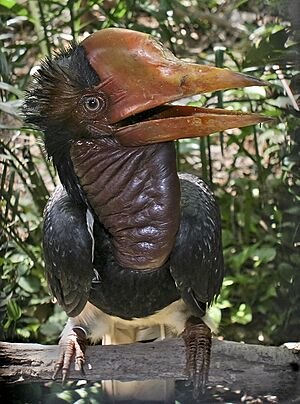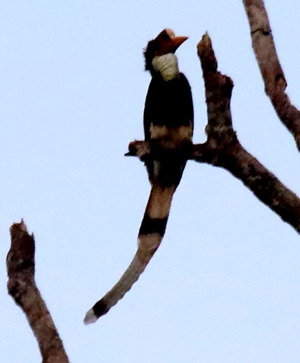Helmeted hornbill facts for kids
Quick facts for kids Helmeted hornbill |
|
|---|---|
 |
|
| immature male at the Jurong Bird Park. | |
| Conservation status | |
| Scientific classification | |
| Genus: |
Rhinoplax
|
| Species: |
vigil
|
| Synonyms | |
|
Buceros vigil Forster, 1781 |
|
The helmeted hornbill (Rhinoplax vigil) is a very large and unique bird from the hornbill family. You can find it in places like the Malay Peninsula, Sumatra, Borneo, Thailand, and Myanmar. This amazing bird has a special helmet-like part on its head called a casque. It's almost solid and makes up about 11% of the bird's weight. Male helmeted hornbills use this casque for head-to-head fights. Some local people, like the Punan Bah, believe this hornbill guards the river between life and death.
Contents
What Does the Helmeted Hornbill Look Like?
This hornbill is mostly black. Its belly and legs are white, and its tail is white with a black band near the end of each feather. The tail is very long, and the two middle tail feathers are much longer than the others. This makes the helmeted hornbill longer than any other hornbill species.
The bird's body is about 110 to 120 centimeters (43 to 47 inches) long. Its extra-long tail feathers add another 50 centimeters (20 inches) to its length. A male bird can weigh around 3.1 kilograms (6.8 pounds). Females are a bit lighter, weighing about 2.7 kilograms (6 pounds) on average.
Special Features of the Helmeted Hornbill
The helmeted hornbill has a bare, wrinkled patch of skin on its throat. In females, this patch is pale blue to greenish. In males, it is red.
The special casque on its head starts at the base of its bill and goes about halfway to the tip. Both the casque and the bill are yellow. A red oily substance from the bird's preen gland covers the sides and top of the casque and the base of the bill. This often leaves the front of the casque and the end of the bill yellow. Unlike other hornbills, the helmeted hornbill's casque is solid. Its skull, including the casque and bill, can be 10 percent of the bird's total weight.
The Helmeted Hornbill's Unique Call
The call of the helmeted hornbill has two parts. First, you hear a series of loud, short hoots, like the sound of an axe hitting wood. These hoots can be double-toned and there can be more than two dozen of them.
These hoots then get faster and faster, ending in a cackle that sounds like laughter. Scientists think this call helps other hornbills know things about the caller, like its age, size, and how healthy it is. Because of this special call, the Helmeted Hornbill is sometimes called the "Tebang Mentua" in Malay, which means "Kill your mother in law" bird. This name comes from an old story about a man who was turned into the bird and now makes sounds like an axe hitting wood, followed by a joyful cackle.
These calls are very loud and can be heard up to 2 to 3 kilometers (1.2 to 1.9 miles) away. They can also last for several minutes at a time.
Habits and Life Cycle
Helmeted hornbills mostly eat the fruit of strangler fig trees. They are thought to be territorial, meaning they defend their living space. They are also believed to be monogamous, meaning they have one mate for life. However, not much is known about how they interact with each other.
Reproduction
These birds breed once a year and usually have only one chick. The mother and her chick stay inside a sealed tree cavity for the first five months of the chick's life. This special way of nesting makes them very vulnerable to poaching (illegal hunting) and deforestation (cutting down forests).
Males fight over their territory while flying. They ram each other with their solid casques. These fights are called "aerial jousting." Females will fly with the males as they approach for a fight, but they turn away in opposite directions just before the collision.
Why the Helmeted Hornbill is Endangered
The helmeted hornbill faces many dangers, mainly from hunting and losing its home (habitat). Because of these threats, its status was changed from "near threatened" to "critically endangered" on the IUCN Red List of Threatened Species in 2015. This means it is very close to disappearing forever. It is also listed in Appendix I of CITES, which means international trade in this bird is almost completely banned.
According to a group called TRAFFIC, over 2,170 hornbill casques were taken illegally in China and Indonesia in just three years. There are now fewer than 100 helmeted hornbills left in the forests of Thailand. In the past five years, at least 546 hornbill parts, mostly casques, have been sold online in Thailand. Traders pay villagers about 5,000-6,000 baht (around US$165–200) for a hornbill head. These prices can double or triple in cities and become much higher when sold to other countries. Currently, no helmeted hornbills are kept in zoos or wildlife parks.
Hornbill Ivory
The casque of the helmeted hornbill is the source of something called hornbill ivory. This is a valuable material used for carving. Local people also use the long central tail feathers to decorate special dancing cloaks and head-dresses. In the past, carvers in China and Japan also used the casque for their artwork.
Cultural Importance
The Helmeted Hornbill, along with the rhinoceros hornbill, is very important in the cultures of many native groups in northern Borneo. These birds appear in many legends and stories. They often represent ideas like life, death, and bravery.
In the Punan Bah culture, helmeted hornbills are believed to guard the path between life and the afterlife. They also judge the worth of people who pass through. This bird is also connected to old beliefs about headhunting. The Orang Ulu people of northeastern Malaysia only allowed those who had taken a head to wear the Helmeted Hornbill's feathers.
Beyond their spiritual meaning, the bird's casques and feathers are used in many rituals and ceremonies. The Orang Ulu carved detailed grave markers, decorations, and earrings from hornbill casques. Many native peoples used the two long, central tail feathers to decorate ceremonial clothes and weapons for weddings, funerals, and other important events. Traditionally, hornbills were hunted for their meat using blowpipes.





